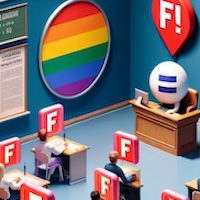A variety of factors led to a third straight flat year in licensing rights fees for 2003, as segment revenues rose only 2% to $6.1 billion, after posting 3% growth in 2002. The main reason for the slow growth was the absence of the sort of blockbuster film that created merchandising opportunities.
“Entertainment licensing accounts for about 44% of all licensing revenues, and when that category is flat or down a little bit, it makes it hard for the overall industry to show any growth,” explains Charles Riotto, president of the New York City-based Licensing Industry Merchandisers’ Association (LIMA). “There was growth in certain segments, but since there wasn’t one huge breakaway entertainment property, that segment was down a few percentage points. We did see growth in the sports, corporate brand and the arts sector.”
Marty Brochstein, editor of licensing industry newsletter Licensing Letter concurred with the LIMA assessment: “The whole entertainment category was down because there was no big movie last year to replace the revenue of the 2002 Spider-Man movie; there was nothing that everybody could kind of gather around.”
The absence of a blockbuster property meant that it was a harder sell to get licensed products significant retail presence, especially in light of the ongoing consolidation at retail. “Licensing is a three-legged stool: the licensor, the manufacturer and the retailer,” explains Brochstein. “Because of the consolidation at retail, it’s tougher and tougher to get a product on the shelves in a meaningful way.”
Sports licensing helped keep 2003 from the brink of disaster for licensors, as retro jerseys and merchandising using non-traditional colors (think Yankee jerseys in green and yellow) helped move product. As sports leagues loosened up on their thinking and expanded their product lines, a small shift in fashion sense helped out also. “Sports licensing has seen resurgence in the last couple of years, in that it’s become cool again as a fashion statement,” Riotto explains.
The corporate brand category saw more and more corporations increasing brand awareness through licensing and brand extensions. Additionally, Riotto points to art licensing as a source of future growth. “Artist’s designs and illustration have become a big business in the last few years. Artists are now licensing their designs into a lot of different product categories, most notable home décor, home furnishings and stationary. There’s a lucrative market there which is still relatively small but fast growing,” he says.
Evergreen properties, such as those managed by Christina Nix-Lynch, licensing director for United Media Licensing, also held their own in 2003. “Peanuts tied in with Pepsi and Frito-Lay, in a generic national promotion that we were able to make account-specific for key retailers like Wal-Mart. So this was an opportunity to lend an entertainment property an added value from the exposure, and we customized it for each retailer,” Riotto says.
Shrek and Spidey spell success in 2004
After several years of flat growth, however, LIMA sees 2004 as the year entertainment licensing propels the industry forward. “2004 could potentially be the biggest year for movie licensing merchandise that we have ever seen,” Riotto claims. He cited-Shrek II, Spider-Man II the new Harry Potter movies as a few blockbusters to watch for.
SNAPSHOT 2003
- Total spending: $6.1 billion (up 2% over 2002)
- Slow growth in the absence of breakout entertainment hits
- Retailers increase dominance over licensed merchandise
 Network
Network

